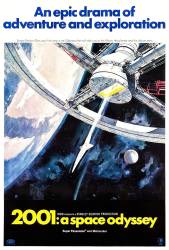Continuity mistake: In the scene where HAL is reading the lips of Bowman and Poole through a pod window, while they are in the pod discussing his possible disconnection, they are shown to be directly facing each other, keeping their heads perfectly still, while HAL looks back and forth from mouth to mouth. In the previous scene, the two men were not conversing in this unusual manner.
Visible crew/equipment: In both EVA scenes, first when Dave retrieves the AE-35 Unit, and when Frank goes to re-install it, there are shots of Discovery in the background, the pod in the foreground and the astronaut floating between. And in both of these shots, the pod rotates 180 degrees. In the front window of the pod, we can see reflected images of the film set and equipment as the pod rotates.
Continuity mistake: As Bowman enters B-pod to retrieve the AE-35 Unit, he lifts his left foot into the pod first. But as Poole is watching him do so on a monitor, Bowman lifts his right foot into the pod first. (01:12:45)
Continuity mistake: In several scenes, we are given HAL's visual perspective as if seeing through his lens. This is done with an overlayed image of the lens on whatever area is in sight of the lens. As Dave is entering HAL's memory circuit room (red lighting), one shot again suggests we are again seeing what HAL sees, but there is no HAL lens located and oriented to provide the angle we see. A lens would need to be mounted on the narrow wall directly opposite the circular doorway, yet HAL's lens in this room is mounted on the 'ceiling'. (01:51:25)
Continuity mistake: In a sequence in the cockpit of the space ship approaching docking, the shot shows the two pilots and 3 monitor screens between them. The right-hand screen changes from a data display to a blank showing only the letters "GDE" (possibly "GOE"). The next shot is a close-up of the three monitors, and the right-hand one now shows its earlier data display. The other two do not show this behaviour. (00:25:00)
Revealing mistake: When Dave Bowman attempts to re-enter Discovery One via the emergency airlock after blowing the explosive bolts on the pod door, where does said pod door go? And also, because of Newton's law of motion, the sudden rush of cabin air during decompression inside said pod after the bolts had blown the door off would have resulted in the pod being pushed in the opposite direction (in effect, that rapid escaping air would have acted like a rocket motor, propelling the pod like a cannonball from a gun!).
Suggested correction: Did you watch the film? The pod bay door doesn't come into it. Bowman enters via the emergency entrance, not a pod bay. The door of the pod and the door of the emergency exit slide sideways into cavities that are there for that purpose - hinged doors don't make any sense in a cramped spacecraft. We see the emergency entrance doorway slide back into position when Bowman activates it.
I think you confused the pod bay door with the door on the pod itself. In the explosive bolt sequence, the pod door does disappear. There is an expanding cloud from the pod door, but no flying door or evidence of it in the emergency airlock. Just an open hole in the pod.
In the scene just before HAL reads the astronauts' lips in the pod, we see that the pod door does slide sideways into the pod hull. The explosive bolts, marked by small red patches, are located in a pattern all around the edge of the door. This indicates that the explosive bolts would blow that section of the door outward rather than sideways into the hull storage pocket.
Bowman programmes the bolts on one side of the door only to detonate, blowing it sideways.
Sure, that might work, but how about this? Bowman knows that the door is constructed of a special composite material that instantly vaporises if it is compressed in just the right way. So, he reprograms the charges to set up a harmonic series of shock wave fronts that destabilises the composite of the door structure, tuning it into the large cloud of smoke we see in the scene.
Continuity mistake: During Heywood's meeting with Elena and Dr Smyslov, he is introduced to their colleagues, including Dr Kalinan who is the women in the olive dress/suit. When they shake hands her coat is folded neatly over her seat, but before she sits down again with the camera now facing Heywood, the coat disappears. In an earlier shot prior to the introduction, the majority of Kalinan's coat is off the seat and when she stood the first time it probably fell, suggesting the handshake sequence was re-filmed after the actual meeting. (00:28:45)





